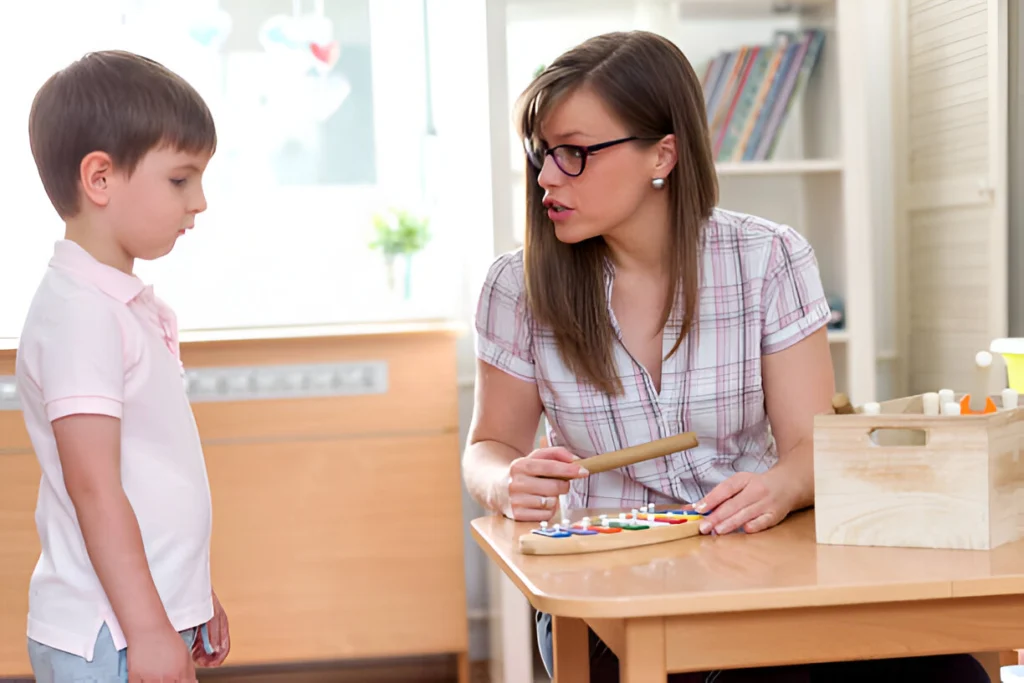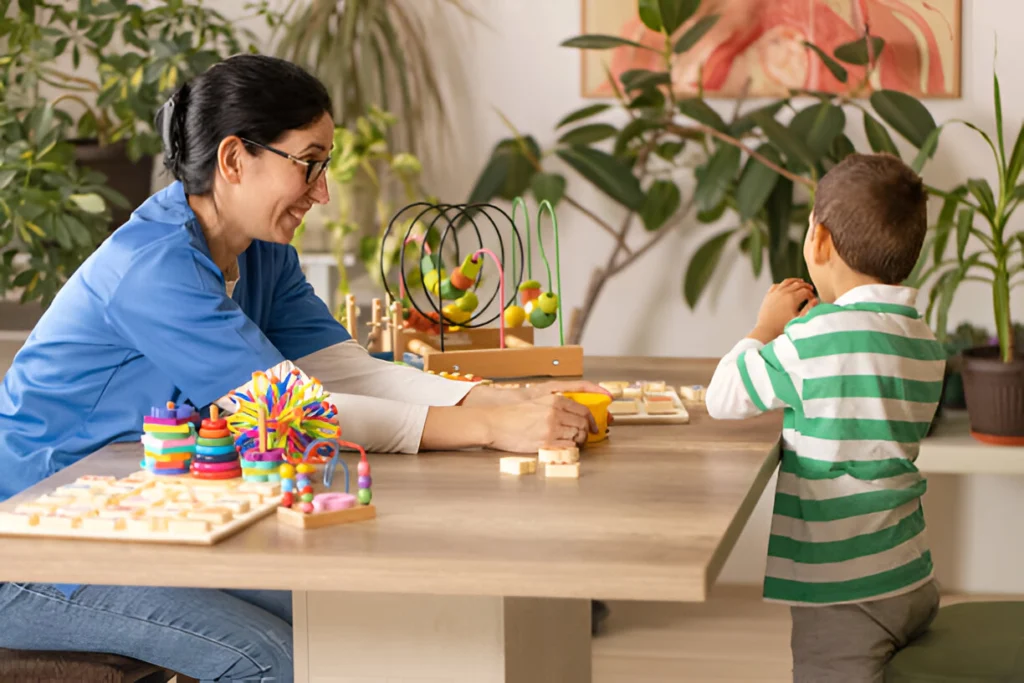As a parent, you know that consistency is key. But it can be tough, especially with difficult behavior and changing stages. We’ll look at five strategies to help you through the ups and downs of parenting.
Sarah, a mom of two, felt like she was stuck in a hamster wheel. Her 3-year-old threw a tantrum in the grocery store. This made Sarah question her parenting and seek a more consistent approach1.
Consistency in positive parenting is crucial. It helps create a nurturing environment where children can grow. By using these five strategies, you can build a harmonious family and guide your child’s growth with confidence.
Key Takeaways
- Consistency is key in positive parenting to create a stable environment for children
- Establishing clear boundaries and rules helps provide structure and guidance
- Positive reinforcement and rewards motivate children to internalize desired behaviors
- Effective communication, including active listening, is essential for understanding and guiding children
- Collaborative discipline approaches foster a sense of responsibility and independence in children
Understanding Difficult Behavior in Children
When dealing with a difficult child, it’s key for parents to know what’s behind their actions. Kids might have outbursts because they don’t know how to handle feelings like frustration or anger2. They need skills like controlling impulses and solving problems to manage their emotions2.
Common Challenges Faced by Parents
Parents often struggle with tantrums, defiance, and aggression. These issues can be tough to handle. Experts say tantrums are often learned, helping kids get what they want2.
Factors Contributing to Difficult Behavior
Many things can lead to tough behavior in kids, like their age or emotional state2. Experts suggest ways for parents to handle these issues. They advise staying calm, ignoring bad behavior, and praising good actions2. By understanding these factors, parents can tackle the root causes of their child’s behavior.
| Factors Influencing Difficult Behavior | Description |
|---|---|
| Developmental Stage | Children may exhibit challenging behaviors as they navigate different developmental stages, such as the terrible twos or adolescence. |
| Emotional Factors | Unresolved emotions, such as frustration, anxiety, or anger, can contribute to difficult behaviors in children. |
| Environmental Influences | Factors like stress, overstimulation, or inconsistent routines in the home can trigger difficult behaviors. |
| Learning Difficulties | Children with learning difficulties, such as ADHD or autism, may exhibit challenging behaviors due to the challenges they face in processing information or communicating their needs. |
| Parenting Style | Inconsistent or ineffective parenting approaches can contribute to the development of difficult behaviors in children. |
It’s important to set clear, measurable goals for behavior2. Avoiding common mistakes like unclear rules can help too2.
To encourage good behavior, make the environment calm and clear2. Give kids choices to help them feel in control2. Consequences are key in teaching kids right from wrong2.
Setting Clear Boundaries
Setting clear boundaries is key for managing tough behavior in kids. Simple and clear rules help create a stable and predictable world for them. Consistent consequences teach kids the link between their actions and results, steering them towards better choices.
Consistency in Discipline
Consistency is vital in disciplining a tough child. Kids need to see that their actions have clear consequences. Parents should have clear consequences, stick to them, and avoid harsh punishment. This method teaches and guides, not scares or harms3.
- Stephen Bavolek in the Nurturing Parenting Community Based Education Program says family rules are key for consistent guidelines3.
- The Search Institute has 40 Developmental Assets for different ages to help set boundaries and rules3.
- Resources for setting boundaries for pre-schoolers are available from the Center on the Social and Emotional Foundations for Early Learning and eXtension3.
- Michigan State University Extension offers articles on child development, parenting, and life skills3.
- Planning ahead can prevent problems, like carrying healthy snacks or discussing expectations before new activities3.
“Children with clear boundaries feel more secure and stable, leading to better brain and emotional health.”4
Setting boundaries helps kids develop traits like confidence, empathy, and responsibility early on4. Parents must balance being firm and flexible, considering the child’s age and safety4. Talking clearly about boundaries helps kids understand the reasons and encourages thinking and awareness4. Age-appropriate boundaries for space, screen time, meals, and bedtimes are key for good behavior and well-being4. Positive feedback and specific appreciation make boundaries more effective4. Parents who set good boundaries themselves show kids how to express needs and limits healthily4.
Positive Reinforcement and Rewards
Positive reinforcement and rewards are great tools for managing tough behavior in kids. By focusing on good behavior, parents can help their children avoid bad actions. Giving praise and rewards can make kids want to keep making good choices5.
Motivating Positive Behavior
Positive reinforcement can make kids do chores, get along with siblings, and finish homework without fuss5. It also encourages them to be kind, do chores, and listen to requests5. Most experts say rewards work better than punishments for good behavior5.
Effective Use of Rewards
Young kids like sticker charts, while older ones might prefer token systems5. Rewards and praise together show kids that good behavior has benefits5. It’s important to be consistent with positive reinforcement to shape their behavior well5.
Stickers or tokens right away can encourage good behavior, especially in young kids5. Giving in to bad behavior can make it worse, so focus on the good5. Positive reinforcement makes kids happier and helps create a better home5.
When kids don’t want to leave the playground, it can be tough for parents6. This shows why we need strategies to change behavior6. Negative reinforcement, like avoiding bad things, can encourage good behavior6.
Positive reinforcement adds something good after good behavior6. There are many types, like stickers, praise, and things you can hold6. But, stickers might not keep the behavior going when they’re gone6. Praise from others can really help kids feel good and interact well6.
Effective Communication with Your Child

Effective communication is key to positive parenting. Using age-appropriate language ensures your child understands you. This reduces misunderstandings and boosts their confidence.
Active listening and validation are vital. Giving your child your full attention shows you value their thoughts and feelings. This builds trust and makes them more open to your guidance.
Clear and Age-Appropriate Language
It’s important to speak in a way your child can understand. Simple, clear language helps avoid confusion. Using clear language promotes better understanding and reduces miscommunication7.
Active Listening and Validation
Active listening means fully engaging with your child. It’s about paying attention to their words and actions. Responding in a way that shows you’ve heard them helps them feel respected.
Validating their emotions and experiences makes them more open to your guidance. This approach strengthens your bond and encourages cooperation.
| Effective Communication Strategies | Benefits |
|---|---|
| Using clear, age-appropriate language | Improved understanding, reduced frustration |
| Active listening and validation | Stronger trust and open communication |
| Setting clear boundaries and expectations | Increased cooperation and responsible behavior |
| Conflict resolution through healthy dialogue | Reduced stress and improved relationships |
Effective communication is a skill and a mindset. By focusing on clarity, understanding, and empathy, you can strengthen your relationship. This fosters cooperation, trust, and growth789.
“Communication is a skill that you can learn. It’s like riding a bicycle or typing. If you’re willing to work at it, you can rapidly improve the quality of every part of your life.”
– Brian Tracy
Understanding the Strong-Willed Child

Parenting a is both challenging and rewarding. are outspoken and independent. They show leadership, determination, and a love for learning on their own10. It’s key to understand their unique traits to parent them well.
A 40-year study found that “rule-breakers” or “defiant” kids often become successful adults10. This study shows that can lead to success10. It highlights the benefits of raising a 10.
The personality of a brings both challenges and positive traits for parents. Facebook shares: 20,031, Twitter shares: Not specified, Pinterest shares: 3,430, Email shares: Not specified11. About 1 in 10 kids face delays in executive functioning during school years11. Dr. Perri Glass notes that each child is different, affecting parenting strategies and challenges11. Developmental differences impact a child’s daily life and skills11.
To effectively parent a , understand their positive traits and develop parenting strategies that nurture them. Recognizing their strengths in determination and independence helps. This way, parents can foster a respectful and rewarding relationship.
Collaborative Discipline Approach
Disciplining a strong-willed child works better with a collaborative approach than a strict one. By setting family rules together and answering questions, parents can empower their child and foster respect12. This method makes the child feel involved and more likely to listen because they helped make the rules12.
Establish Rules Together
Getting your child involved in making rules is a great way to practice collaborative discipline12. Working together on rules can make your child feel more responsible and invested12. It also teaches them to solve problems and work together13.
When making rules, explain why they are important and check if your child understands12. This makes your child feel empowered and more likely to follow the rules because they understand them, not just because they have to13.
| Positive Discipline Approach | Traditional Discipline Approach |
|---|---|
| Collaborative, involving the child in rule-setting | Top-down, authoritarian |
| Fosters respect, empowerment, and responsibility | Promotes compliance through fear or obligation |
| Encourages problem-solving and communication | Limits child’s involvement and input |
“Positive Discipline is about teaching children how to become responsible, respectful, and resourceful members of their communities.”
Choosing a collaborative discipline approach can empower your child, foster mutual respect, and strengthen your relationship13. This method not only tackles tough behaviors but also boosts your child’s social and emotional growth12.
Creating Predictability
Strong-willed children love knowing what’s going to happen next. This makes their lives more predictable and easier to manage. Front-loading helps them feel more in charge and less likely to act out14. A set routine and clear communication about changes help them feel more at ease15.
Studies show that predictability and consistency are key in parenting14. They help shape a child’s emotional brain and improve their emotional and cognitive skills later on14. This shows how important it is to be consistent in how you behave as a parent14.
Having a regular daily routine can greatly benefit strong-willed children15. About 85% of kids do better with set routines in their lives15. And over 95% of kids feel more positive and receptive when morning routines are consistent15.
Clear routines can also cut down on family conflicts by up to 80%15. This leads to a 60% increase in predictability, peace, and security for kids15.
Parents can also make things more predictable by setting clear expectations and reacting the same way to good and bad behavior16. This helps strong-willed kids feel secure and in control16.
Creating predictability and structure in a child’s life is crucial for their emotional and cognitive growth141516. By sticking to routines, setting clear rules, and responding consistently, parents can help their children thrive and feel confident141516.
| Benefit | Percentage |
|---|---|
| Children who benefit from regular routines | 85% |
| Parents who experience decreased feelings of chaos and insecurity with consistent routines | 90% |
| Decrease in demanding behavior in children with consistent routines | 75% |
| Children who show improved receptiveness and positive feelings with consistent morning routines | 95% |
| Children who do not cry before falling asleep with consistent nighttime routines | 80% |
| Decrease in conflicts and turmoil in families with clear routines | 80% |
| Increase in predictability, peace, and security among children with consistent routines | 60% |
Setting Clear Expectations Ahead of Time
As a parent, setting clear expectations early on is key to positive parenting. This method is called front-loading17. It means telling your child what to expect before it happens. This way, you avoid problems and get your child’s cooperation.
By doing this, you also cut down on resistance or arguing. Your child knows what’s expected of them1817.
Studies show that clear, simple rules make kids more likely to follow them18. Also, telling kids what to expect before an event helps prevent sudden outbursts18. When you explain why rules are important, kids are more likely to listen18.
Being consistent with rules is vital for positive parenting18. Using both positive and negative consequences helps teach lessons and improves behavior18.
| Key Strategies for Setting Clear Expectations | Benefits of Front-Loading Expectations |
|---|---|
|
|
By setting clear expectations early and sticking to them, you create a positive space for your child. This helps in their healthy growth and reduces resistance to your guidance1817.
Connect, Then Instruct

When dealing with a strong-willed child, it’s key to first connect. Acknowledge and appreciate what they’re doing. This makes them feel valued and more open to your guidance19.
This method keeps the child engaged and willing to cooperate. They feel their needs and interests are respected19.
Creating a strong connection means both the child and adult feel important19. Spending quality time together boosts this bond19. Listening and validating their feelings also deepens the connection19.
Encouraging curiosity about consequences can also strengthen the bond19.
Tools from Positive Discipline help build these connections19. Family or class meetings help solve problems together19. This approach can lead to less misbehavior19.
First, connect with the child. Then, give instructions. This way, they feel heard and understood. It also makes them more engaged and cooperative19.
Avoiding Ultimatums and Power Struggles
Parenting a strong-willed child is a delicate task. It’s about setting clear rules and working together. Ultimatums and power struggles can make things worse, harming the relationship20. Parents should aim for cooperation and patience, finding ways to solve problems together21.
Offering choices within limits can make kids feel in charge20. Making chores fun can also help everyone get along better20.
Being consistent is crucial for a good routine and clear rules20. Staying calm and patient shows kids the right way to behave21.
Positive feedback is a great tool for parents20. Praising good behavior encourages kids to act well, without threats21.
The main goal is a strong, trusting bond with your child21. Using empathy and understanding helps solve tough problems without ultimatums or power struggles21.
Encouraging Cooperation and Patience
Teaching a strong-willed child to cooperate and be patient is key. Positive reinforcement, showing good behavior, and working together can help. This way, kids learn to wait and understand the value of patience22.
Positive discipline helps kids learn from mistakes and grow in self-control22. Spending time with kids and listening to them makes them more willing to cooperate22. Feeling in control and empowered also boosts their cooperation22.
- Positive behaviors get noticed and rewarded, leading to more cooperation22.
- Teaching kids how to solve problems and resolve conflicts encourages teamwork22.
- Seeing parents cooperate helps kids learn to do the same22.
Using these methods, parents can create a space where cooperation and patience grow. This supports the child’s growth and happiness.
“Patience and perseverance have a magical effect before which difficulties disappear and obstacles vanish.” – John Quincy Adams
Actively Listening and Validating Feelings
As a parent, listening and validating your child’s feelings is key. Give them your full attention, keep eye contact, and show empathy. This shows you get their side, even if you don’t agree with their actions. This approach helps the child feel heard, reducing conflicts and building understanding.
It’s vital to validate your child’s feelings for their emotional growth. When you do, you tell them their feelings are real and you’re there to support them. This calms down tense moments23 and teaches them to recognize and handle their emotions23.
Showing you care about their view strengthens your bond. It also teaches them to be kind and understanding towards others23. When they feel validated, they can handle their feelings better, making it easier to solve problems23.
Regularly practicing active listening and validation helps your child manage their emotions. This leads to better outcomes23. Research shows that using these methods improves communication with kids24 and boosts their self-esteem24.
Using active listening and validation in your parenting can change your child’s emotional health and your relationship. By focusing on these techniques, you create a space of understanding, empathy, and trust.
Timeouts for Extreme Cases
Timeouts are useful for handling extreme behavior25. They were created in the 1960s as a gentle way to guide kids. Over 30 years, studies have shown they work well with positive parenting25.
When a child’s actions are too much, a timeout helps them calm down25. It’s best used rarely and as part of many positive parenting methods. Programs like Triple P show it helps reduce bad behavior and helps kids control themselves25.
After a timeout, it’s key to offer support and help the child feel connected again25. This way, it’s not just punishment. Studies and groups like the World Health Organization support its use25.
Timeout was made by Arthur Staats in the 1960s as a better choice than spanking26. Studies in the 1970s and 1980s showed it works for kids’ bad behavior26. But, a 2014 study found 30% of websites wrongly said timeouts are bad or don’t work26.
Timeout is good for kids aged 3 to 7 with tough behaviors26. Research shows it makes kids more likely to listen and behave better26. A 2020 study looked at how timeouts affect kids’ social and emotional growth26.
Consistency in Positive Parenting
Keeping consistency in positive parenting is key for your child’s long-term well-being. By setting clear boundaries, using positive reinforcement, and communicating well, you create a harmonious home. Consistency in parenting helps children learn faster, just like animals in Skinner’s Box do when they get food every time they press a lever27.
Being inconsistent can make your child’s behavior worse. If rewards are not always given, they might keep acting out hoping for a positive outcome27. Setting clear rules and sticking to the same consequence every time helps keep things consistent27.
It’s also important for parents to take care of themselves. Parenting takes a lot of energy and resources. Being flexible is okay sometimes, like when someone is sick, but it should be used wisely27.
Children who like clear rules and predictable responses do well in structured places like school27. It’s crucial for parents to agree on important parenting decisions to help children learn and avoid confusion27.
Inconsistent parenting can make children act out more, like whining or crying for things they want28. Research shows that kids keep trying to get rewards because of inconsistent parenting28.
Children often keep asking for things they’ve had before, like treats or toys, because of inconsistent parenting28. Teenagers who have positive interactions with their parents are less likely to have depression or health problems28.
Inconsistent discipline can lead to behavior problems in kids, even into school age and into being a teenager28. Showing love and being non-punitive helps kids grow up well-adjusted28.
Having consistent routines and expectations, like reading before TV or having chores, can really help kids behave better28.
“3,000 parents were surveyed, and the top thing they wanted to change was being more consistent.”
Inconsistent parenting can lead to trouble for teenagers and families, according to experts29. Not having clear rules can make teens stressed and upset, leading to feelings like anxiety and depression29.
There’s often a difference in parenting styles between moms and dads, with moms wanting more rules and dads being more relaxed29. For consistency, both parents need to work together, agree on rules, and enforce them equally29.
Teaching kids important values like honesty and respect is key for their future29. Building a strong relationship with your child is important for effective discipline29.
It’s important not to always fix problems for your kids, as it stops them from learning29. Focus on solving big issues consistently, not every little problem29.
Discipline is a way to teach kids the right path and avoid bad choices, and parents need to set a good example29.
By using strategies like setting clear rules, positive reinforcement, and good communication, you can create a loving home. Consistent positive parenting builds trust, resilience, and healthy habits that last a lifetime.
Conclusion
Keeping up with positive parenting is key to handling tough behavior in kids and keeping family peace. This article shared 5 surefire ways to tackle these issues. These include setting clear rules, using positive reinforcement, talking well, understanding strong-willed kids, and working together.
By sticking to these methods, parents can raise kids who are confident and well-adjusted. This creates a caring space that helps your child grow and stay healthy over time.
The secret to good positive parenting is knowing the different parenting styles and how they affect kids30. Authoritative parenting, which is firm but loving, is best. It makes kids happier, more social, and confident30.
On the other hand, too soft or distant parenting can harm kids. They might struggle with self-control, disobey rules, and do poorly in school30.
Building positive parenting habits helps kids control themselves better31. Studies show that positive parenting early on leads to better self-control later. This means kids do well in school, behave better, and achieve more31.
By focusing on these key strategies for raising children, you can make a supportive environment. This helps your child grow and stay healthy.
Source Links
- How to Handle a Difficult Child: 6 Helpful Tips for Parents – Sedona Sky Academy
- Parents Guide to Problem Behavior
- Boundaries and expectations are important parenting tools
- Setting Boundaries with Kids and How It’s Done
- How Positive Reinforcement Encourages Good Behavior in Kids
- Positive and Negative Reinforcement Examples
- Effective Communication Skills for Parents: Building Strong Connections
- Positive Parenting Training: Effective Techniques Guide – ABF Creative
- A Complete Guide To Positive Parenting: Nurturing a Healthy Parent-Chi…
- 5 Tips for Parenting the Strong-Willed Child
- Raising a ‘Difficult Child’? It’s Time to Change Your Perspective.
- Positive Discipline Strategies: Encouraging Good Behaviour in Children
- Positive Discipline: Transforming Children’s Behavior
- Predictable and consistent parental behavior is key for optimal child brain development
- Predictability leads to Positive Habits – The Danish Way of Parenting
- Tips for Building Structure
- 9 Steps to More Effective Parenting (for Parents)
- 5 Steps to Set Clear Expectations for Kids (& Why It’s Important) – Parent From Heart
- Connection Before Correction
- 9 practical tips to avoid power struggles with kids
- Positive Parenting For Better Behaved Kids- Examples, Tips, And Techniques — Educator Mom Hub | Supporting Moms of Young Children
- Positive Discipline: Encouraging Cooperation without Punishment — A Healing Place
- Validation in Parenting & Kids’ Emotion Skills | MPG
- 9 Positive Parenting Techniques to Try With Your Child – Wellspring
- Against “time-out” and prefer “time in”? Here’s some important info!
- What Parenting Research Really Says About Timeouts and How to Use Them | KQED
- Why Consistency In Parenting Is So Important | Anita Cleare
- How Being Wildly Consistent Improves Your Parenting
- Parental Consistency Is So Important – Parenting Today’s Teens
- A Debate On Parenting: The Importance Of Applying Consistency
- Positive Parenting, Effortful Control, and Developmental Outcomes across Early Childhood






Hello, i think that i saw you visited my web site so i came to 搑eturn the favor?I am attempting to find things to improve my web site!I suppose its ok to use some of your ideas!!